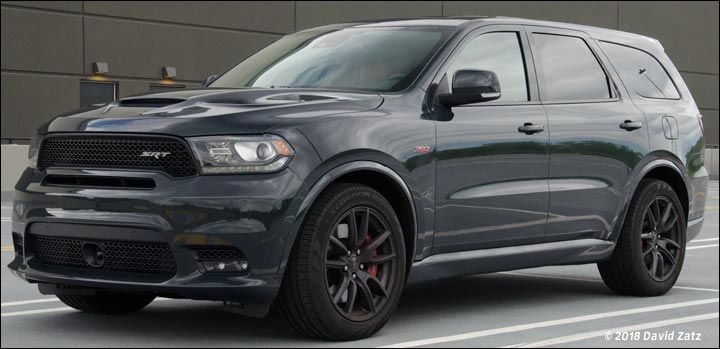
The Dodge Durango SRT has tons of torque and towing capacity, with three rows of seats to set it apart from the Grand Cherokee Trackhawk (née SRT). With all wheel drive putting power to the ground, the big SUV allows for instant acceleration on wet concrete — from zero, from 50, and quite probably from 100 miles per hour. It also allows for instant deceleration — it’s rated 60-to-0 in 115 feet.

It’s no surprise, really, that Mopar fans have been demanding a Dodge Durango SRT for years; the Durango is based on the Jeep Grand Cherokee, with a longer body and a street-tuned suspension, so fitting the 392 V8 engine and bringing the brakes and suspension to SRT standards should have been relatively easy.
Packing a 475 horsepower engine with 470 pound-feet of torque (at just 4,300 rpm), the Durango SRT has the right numbers for enthusiasts; you can race Camaros and Mustangs in the quarter mile, while towing a 8,700 pound trailer. Huge Brembo brakes, with bright red calipers clearly visible through the wheels, bring the two-and-a-half-ton SUV to a rapid stop, while the beefed-up suspension makes the three-row Durango surprisingly capable in turns. According to the SRT Performance Pages, our loaner Durango SRT had a “best” 0-60 time of just 4.2 seconds, though the official NHRA-certified number is 4.4 seconds, with a 12.9 quarter mile. It’s the fastest three-row SUV you can buy.
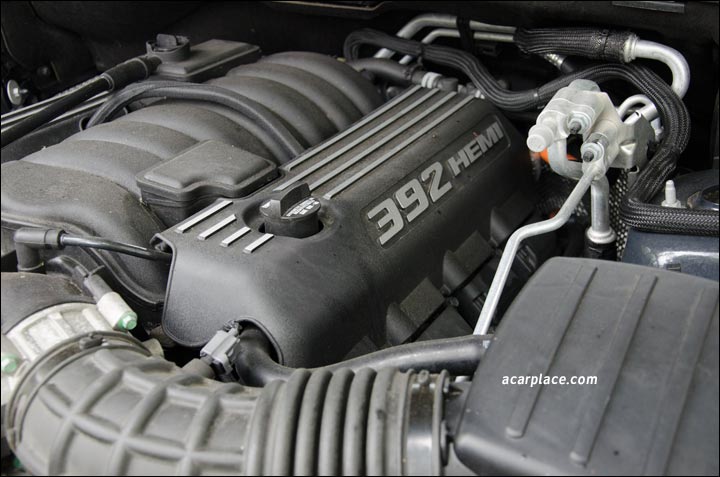
Is such a vehicle practical for daily life? To find out, we tried taking one for a 200-mile drive, moved some furniture, and ran errands around town. As an added bonus, we were able to use concrete roads and highways in the rain, which can test the mettle of any sport vehicle. With some exceptions, most notably gas mileage (which is no surprise), the Durango SRT proved perfectly adept as a regular road car as well as a performance car.
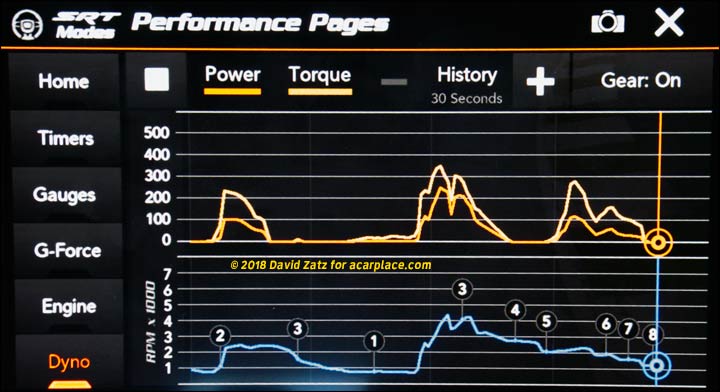
Let’s get gas mileage out of the way. It’s not good, even for a 392 (6.4 liter) V8 car. The Dodge Charger SRT is rated 15 city, 25 highway (though it’s rear wheel drive only); the Dodge Durango SRT, with the same engine and all wheel drive, drops down to 13 city, 19 highway. 18 mpg is more realistic for normal highway driving, even with the economy mode — and be happy with that; if the Hemi didn’t have a four-cylinder mode, which was used quite a bit on level highway, it would probably be 16.
The 392 cars all take premium fuel, too — which costs anywhere from 20 cents to 70 cents more than regular. Still, my guess is that, if you’re looking at the Durango SRT, you’re not worried about gas mileage; that’s what the Durango V6 and Chrysler Pacifica (18/28) are for.

In essence, the tradeoff is instant-on torque, 475 horsepower, comfortable seating for six, and pickup-like towing, in return for burning a good deal more fuel. If you do a good deal of towing, a pickup might not really provide much better mileage, and won’t be anywhere near as fast.
The horsepower rating is all fine and good, but the 392 really shines with torque — 470 pound-feet of it, coming up right off idle. The Performance Pages claimed that the big engine was putting out around 190 pound-feet of torque while I was coasting on the highway. That’s more than my own Dodge Dart is capable of, at its peak.

I loaded up the truck with six people (one of whom weighed nearly 300 pounds) and some luggage, and couldn’t tell the difference in responsiveness, going uphill with the air conditioner on. Extrapolating from there, perhaps towing with the full 8,700 pound load would be a little noticeable, but you’d still easily outrace a normal, unloaded V8 Durango.
The eight-speed automatic transmission helps to keep things responsive yet efficient. In normal mode, the transmission shifts extremely rapidly, making up its mind instantly and moving to match. I was surprised at how well-tuned the system was, expecting slower shifts, the occasional bump-shift, maybe sticking to a gear and refusing to drop down as I coasted — and none of these happened. The eight-speed was perfectly tuned in road mode. 98% of the time, that is likely all you need, since the engine responds so quickly and has so much torque on tap. There also also an economy mode, which is more what I was expecting and not worth the slight increase in mileage, and a sport mode, which is more aggressive and, for most drivers, also unnecessary. (The transmission and suspension have separate sport modes, so you can make the suspension tighter and more responsive without affecting the transmission.)
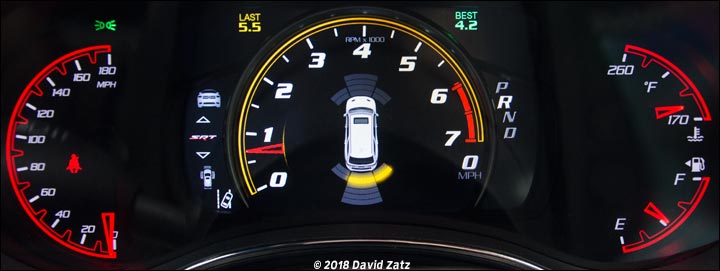
The entire time you drive the Durango, there’s a deep-throated growl from the engine, which was somehow tuned to be the same for four and eight cylinder mode. In some cars, it gets annoying after an hour or two; in the Durango, it was quiet enough to be enjoyable throughout the long trip, radio or no radio.
All wheel drive is a major comfort with the massive horsepower and torque. You can slam down the gas for a left-hand turn across a concrete road, and not lose any grip or squeal your tires. Try that with a Charger SRT, and you’ll find yourself oversteering (though not as much as you would with a 1970s Charger). While rain calls for moderation, it was still pleasant to see that the traction control didn’t come on under reasonably rapid acceleration on wet concrete roads. (Why do I keep pointing out “concrete roads”? Because they are far more slippery, wet or dry, than blacktop; while the nature of their construction, as large tiles with gaps between to allow for expansion and contraction in heat and cold, result in a constant bump-bump-bump as you drive. I’ve driven cars that were terrifying on concrete — fortunately, no Mopars — even though they were well-behaved on blacktop. If the suspension is too stiff, the bump-bump-bump quickly becomes fatiguing.)
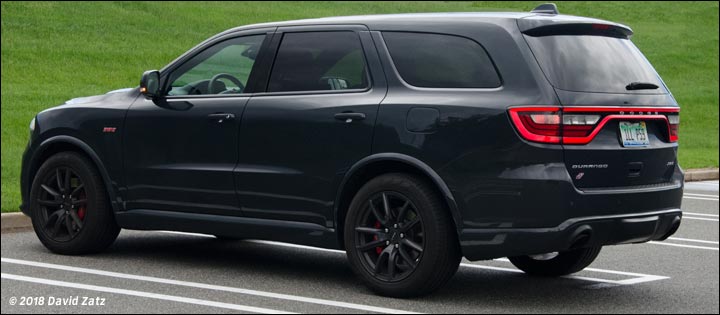
The Durango SRT has an active suspension, with Street, Sport, and Track options. I was happy with the default setting, which balances ride quality against performance. Yes, there’s plenty of road feel, and it’s still firmer than the other Durangos, but it’s not a punishing ride. Driving down concrete roads is comfortable enough; big shocks are soaked up, while smaller “messages” get through. Sport was also well-balanced, with a bit more passed through over big bumps, and a little better control. Track went too far for nasty public roads, but, well, is probably just right on the track or on good pavement.
The Durango stuck to curves quite well, better than I remember the Grand Cherokee SRT, in fact — perhaps the longer wheelbase helps with comfort, while differences in the design and geometry favor performance. (That was one argument made in the Allpar forums for doing a Durango SRT in the first place.)
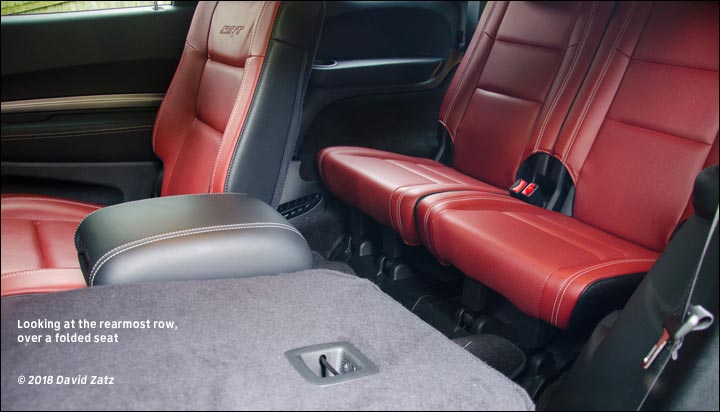
Stopping comes in a real hurry, and without fuss, which can be a life-saver, not to mention a grille-saver. Braking may be even more impressive than the acceleration, with little nose-dive or loss of control.
Steering seemed to have just the right effort in Sport mode; Track mode provides a good amount of resistance, with enough power boost to make corners easy and precise, while building some arm muscle. Street mode is also a good balance, but once I tried Sport, I was sold on it. The same went for the suspension: Sport isn’t punishing, and gives a bit more feedback than Street, while Track is probably overkill. (You can tune the AWD and transmission separately.) The tuners and suspension engineers deserve applause for making a car that’s this big and heavy, this responsive, and this easy to drive long distances on mediocre roads.
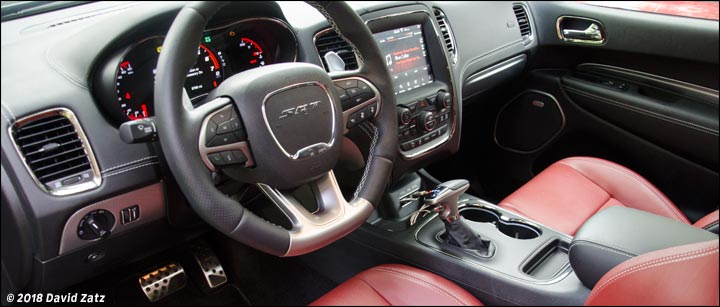
Inside, the Durango looks quite luxurious, with the black-and-Radar-Red Laguna leather seats in all three rows; ours had the captain’s chair configuration in the middle, with two cushions for the bench seats in the rear, allowing seating for six. Leg room suffers a little from the comfortable chairs, something you will likely only discover in edge cases; we carried tall people in all three rows, for example. They could use thinner seats, as they do in the minivans, but it would reduce the comfort and support somewhat. The middle-row seats had their own center console, with a deep storage bin, as well as their own temperature controls; the Durango comes with three-zone automatic temperature control, as well. All together, it makes for a car that won’t wear you out on a long road trip — it’s easy on your back and your butt.
Getting people into the rear was eased by the “flip and tumble” center seats; pull a strap and they fold in half (you can slide long cargo on top of them in that position), pull another and they lift up to provide a relatively easy path to the rear seats. When the driver is on their own, or just has a front passenger, they can press a button in the center display and every middle and rear seat’s headrest will flip forward, for a clear sight path through the rear window — a real time-saver.

Cargo space is limited by the thick seat cushions; they are comfortable but don’t fold particularly low, so you end up without nearly as much cargo space as in a typical minivan. The muscular, fluid styling also takes its toll on the rear door opening and rear width, again cutting back on cargo capacity. Fortunately, with the standard towing gear, you can hook up a cheap U-Haul or your own trailer to tote things around.
Headroom is good in every row, and shoulder and hip room are quite generous with the six-seater configuration. Sound insulation is very good, and road noise is minimal, overwhelmed by the low growl of the engine. The Beats stereo has fine clarity, though, oddly enough, you have to push up the bass a bit to get it to good levels; most likely, the designers knew most owners would boost the bass regardless (as people “autosalt” at restaurants) and set it up for optimum sound that way. The system read our USB drive extremely quickly, and the navigation was instantly responsive — truly instantly, which we haven’t seen on many cars. The big UConnect stereos still handle large USB drives better than most competitors, and while I could complain about handling of Mac-specific files, nobody really deals with those; the onus is on the Mac people, not the automakers (OptiUSB is a good solution).

The seven-inch gauge cluster display is nicely integrated, with physical borders separating sections of the display to make it more subtle. You can view the usual variety of information, such as fuel economy, navigation, trip information, or various temperatures and pressures; when you do, a digital speedometer appears on the tachometer, all the way at the high end of the scale. If you choose to use the digital speedometer, and you very well might reluctantly do that all the time, the speed display moves from the end of the tachometer to the center. The control for the gauge cluster display is on the left side of the steering wheel, using a generous five buttons.
The 8.4 inch display is used for all sorts of things, including adjusting the suspension, steering, and such, and showing a full collection of SRT Performance Pages.
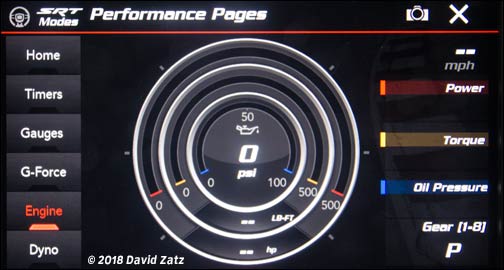
The image above shows calculated horsepower, torque, and oil pressure at the moment — they vary by engine speed. Watching the gauges shows how horsepower climbs relatively slowly, while torque hits a high level right from idle and quickly reaches stratospheric levels. This engine easily outperforms the classic 426 Street Hemi, consistently, and does so starting at much lower engine speeds.
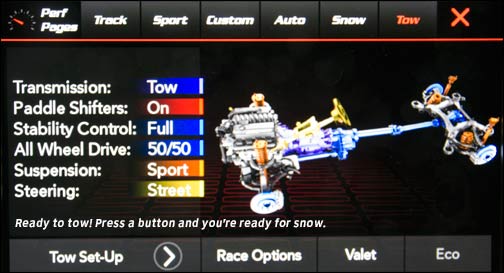
There are a few preset combinations of settings, including Tow mode, above, Snow, Track, Sport, and automatic. If you want to tame down the vehicle, Valet mode imposes strict limits, while Eco mode does the best it can to conserve fuel. Most everything can be customized; the screen below shows how you can set up the Custom mode.
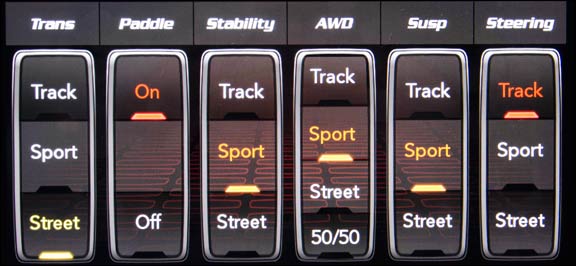
There are clear differences between the various modes (“Paddle” enables or disables the paddle shifters in the steering wheel). I found the Street setting for the transmission to be the ideal, since it shifts with great speed regardless. If I were to race the Durango, I would probably simply use Track mode. I have steering set to Track because it’s easier than going to a gym.
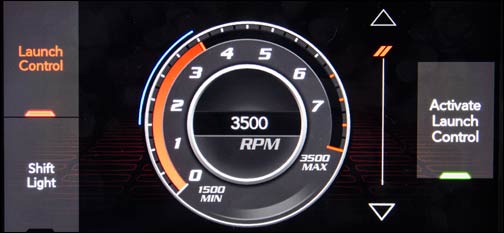
Launch Control lets you choose a base engine speed and have the computer control your sprints. There’s one physical button that gets you to the SRT pages, and another takes you straight to Launch Control.
I do have some complaints, including the disorganized collection of “apps” on the screen. Instead of an integrated Audio app, you get Radio and Media; you can switch between them easily from the steering wheel, so that’s not a big complaint. Likewise, you can drag the icons around on the screen to customize it to your preferences and needs, which makes life much easier. The volume knob often has a noticeable lag, which is an odd behavior starting in the 2015 models; you can get around that by using the steering wheel volume button, which I don’t want to think too hard about.
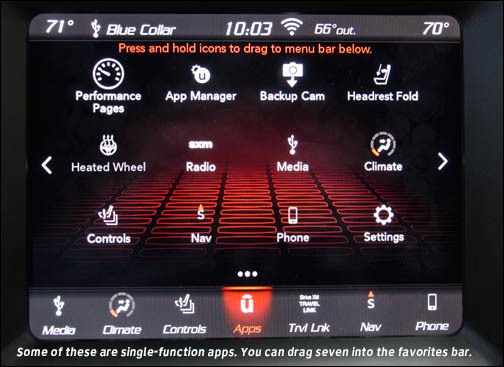
I do appreciate the company putting a searchable version of their owner’s manual into the display, which helps if, say, you suddenly need to know what type of oil or replacement bulb to get, or forgot how the seats work, or need some help configuring the video (left and right video screens can show media from different sources, so there’s some natural complexity at work).
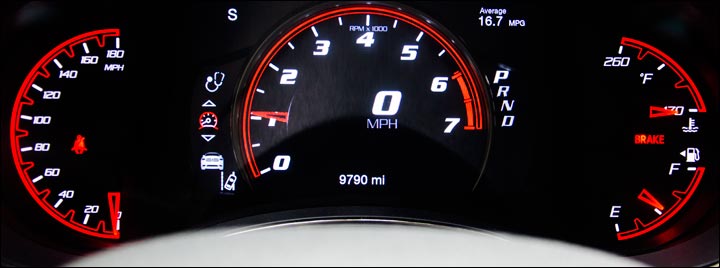
My main complain is really with the speedometer. It’s a “half-gauge,” whose sweep only covers the left side of the gauge, and with a 180 mph range, there’s not enough space to maintain legal speeds easily. Combine that with my weakening eyesight, and I had a choice of buying bifocals for driving, or using the digital speedometer display. That can either be quite large, in the center of the tachometer (top photo), or small, placed under the “7” on the tachometer (bottom photo). Perhaps it should be colored, to set it apart from the scale.
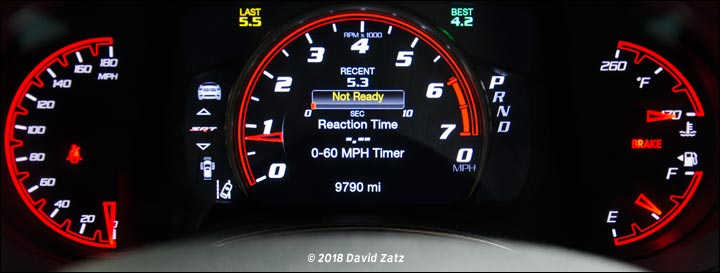
Given that this car’s an automatic and the tachometer scale isn’t very important compared with where the pointer is in the sweep, I’d have much preferred Dodge to move the tachometer to the small gauge on the left, and use the large center gauge for the speedometer (which would be relatively easy, since the left gauge is merely a voltmeter and the center gauge is all digital). That would both provide a much larger sweep and allow for larger numerals. In everyday driving with an automatic transmission and 475 horsepower, a speedometer is more important than a tachometer — and how many people will race their Durangos at the track using the paddle shifters rather than Track mode, even with the SRT package?
The wrap
Is it possible for a big three-row SUV, with a higher tow rating than the Ram 1500 diesel, to be a true SRT? It seems that it is. The Durango has the usual SRT gizmos and features, including street, sport, and track settings for the suspension, transmission, steering, and such, and the hardware to back them up.
It was a source of constant amazement to see and feel the Durango roar to highway speeds from a stop, regardless of pavement quality, without losing traction. That alone provides a level of confidence you don’t get in a Challenger SRT unless you’ve been very well trained and seasoned. The brakes and suspension were more than up to the task of dealing with an overpowered 5,000-pound SUV, as well. Yet, interior comfort was quite good, albeit at the cost of cargo space (since the comfort-oriented seats don’t fold all that small), and with limited legroom.
You can compare our Durango, outfitted with numerous options, against a Cadillac Escalade. The latter has a 420-horsepower V8, with 460 pound-feet of torque, drinks premium fuel (14/21 mpg in the 4×4), and costs thousands more; while some of the Durango SRT options are standard on the Caddy, the Dodge is still more powerful, tows more, handles better, and costs less.
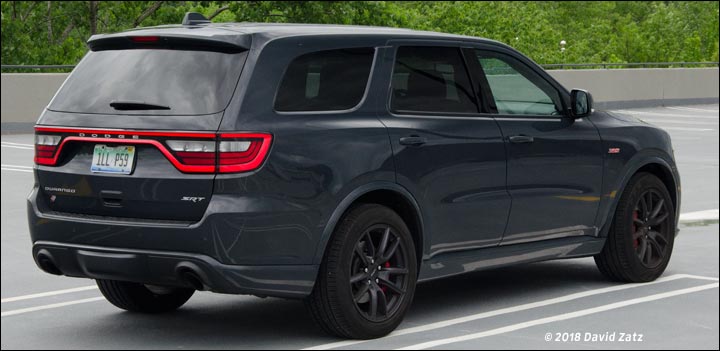
Some claim the Durango SRT is targeted at those who need to tow their cars to the track, as a replacement for the ubiquitous full-size Chevy and GMC SUVs. The Durango can tow an incredible amount of weight, and the 470 pound feet of torque mean never having to say you’re sorry about taking the hilly road on a hot summer’s day, with five passengers, a full trailer, and the air conditioning blasting. How many of these big vehicles are actually used for driving to the track will likely stay a mystery; there are people who have more than two kids and don’t want to give up their muscular V8s, or who want the predictable control only all wheel drive can provide. Either way, the Durango SRT steps ahead of the Jeep Grand Cherokee SRT in many ways, and stands alone as the fastest, most powerful three-row vehicle you can buy.
The Durango is assembled in Detroit; the Hemi hails from Mexico, and the transmission from ZF in the United States (it has 62% US content). The base price is $62,995. Our test car had numerous options — black and red Laguna leather seats, $1,595; Technology Group with blind spot monitor, rear cross path detection, adaptive cruise with full stop, and front collision detector, $2,495; rear DVD, $1,995; trailer tow group, $995; SRT interior appearance group, $1,500; augmented second-row console, $495; power sunroof, $1,195; and special wheels, $595. That and a $1,995 destination brought the total to $74,955.

David Zatz has been writing about cars and trucks since the early 1990s, including books on the Dodge Viper, classic Jeeps, and Chrysler minivans. He also writes on organizational development and business at toolpack.com and covers Mac statistics software at macstats.org. David has been quoted by the New York Times, the Daily Telegraph, the Detroit News, and USA Today.

Leave a Reply